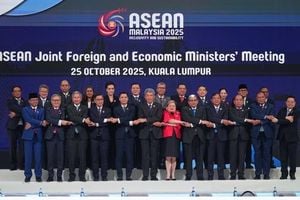The study investigates the dynamic behavior and effective mechanical properties of architected metal/polymer interpenetrated phase composites (IPCs) using finite element modeling. Researchers have focused on four distinct types of Triply Periodic Minimal Surfaces (TPMS) and lattice architectures, including gyroid, primitive, cubic, and octet, utilizing aluminum alloy as the reinforcing phase and epoxy as the matrix material.
This research is particularly significant as it delves deep into the mechanics and structural integrity of materials intended for diverse applications spanning various sectors from aerospace to automotive engineering. Unlike conventional composites, which often showcase limited functionalities, architected IPCs promise enhanced performance through their unique structure.
The authors employed finite element analysis to understand how the effective mechanical properties and dynamic responses of these composites evolve. Utilizing periodic boundary conditions during simulations enabled the identification of how different architectural frameworks affect overall composite behavior.
One of the key conclusions drawn from the study indicated the effective properties of IPCs increased with the volume fraction of their architectural components. This enhancement correlated to elevated natural frequencies and reduced deformation during dynamic stress applications, demonstrating the material's superior ability to withstand real-world conditions.
Specifically, the researchers found, "The effective properties of IPCs increase with respect to the volume fraction of respective architectures," showcasing how innovative material science can propel forward engineering applications. The study also established a comparative backdrop, contrasting traditional composite structures against the newly architected alternatives, emphasizing the significant advancements IPCs provide.
The modal analysis conducted during this research revealed another layer of insight, with findings indicating, "Modal analysis reveals TPMS/lattice-based IPCs have higher natural frequencies than conventional composites," fundamentally outlining how these architected materials not only outperform their traditional counterparts but also present avenues for improved safety and resilience.
Crucially, the study examined the integration of TPMS architectures within IPC designs, discovering their explicit influence on effective elastic properties and the stress responses of the full composite structures. Observing the mechanical response, it became clear, "The elastic properties and how the material responds to the stress of the present IPCs are evidently affected by the TPMS architecture phase integrated,” pointing toward the significance of architected designs in future research.
This article not only adds depth to our current arsenal of material science knowledge but also outlines future pathways for research initiatives. Emphasizing the unique capabilities of architected composites reinforces the notion of their promising application spectrum. The prospect for industrial applications is vast, with potential to redefine expectations across engineering fields.
"This research provides insights and explanations for developing advanced architected composite structures," the authors articulated, leaving the scientific community with renewed hope and direction as innovations continue to push the boundaries of composite material applications.



